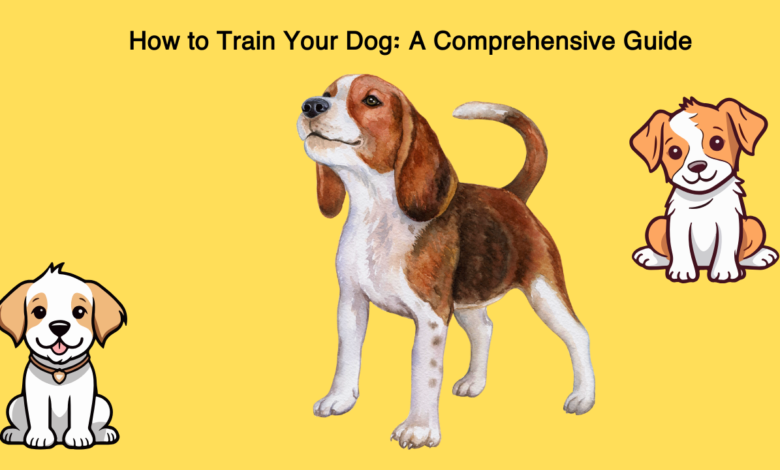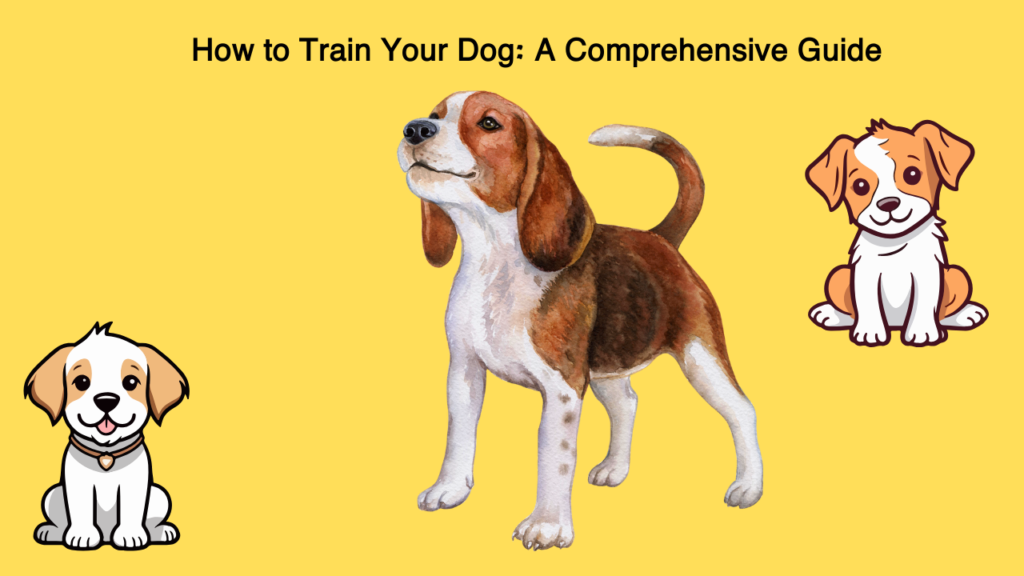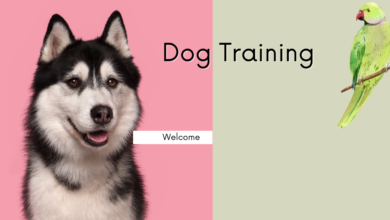
Training your dog is essential for a harmonious relationship between you and your furry friend. A well-trained dog is not only a joy to be around but also safer and happier.

This comprehensive guide covers everything you need to know about dog training, from basic obedience commands to advanced tricks and behavior modification techniques.
Understanding the Basics of Dog Training
- Positive Reinforcement:
- Positive reinforcement involves rewarding your dog for desired behaviors. This method is widely considered the most effective and humane approach to dog training. Rewards can include treats, praise, or playtime.
- Consistency and Patience:
- Consistency is crucial in dog training. Use the same commands and reward system each time. Patience is equally important, as dogs learn at different paces. Avoid getting frustrated and maintain a calm, encouraging demeanor.
- Timing:
- Timing is essential in training. Rewards should be given immediately after the desired behavior to help your dog make the connection between the action and the reward.
Basic Commands
- Sit:
- One of the first commands to teach your dog. Hold a treat close to your dog’s nose, then move your hand up, allowing their head to follow the treat and causing their bottom to lower. Once they’re in the sitting position, say “Sit” and give them the treat.
- Stay:
- Start with your dog in the sitting position. Open your palm in front of you and say “Stay.” Take a few steps back. If they stay, reward them. Gradually increase the distance and duration.
- Come:
- Use this command to call your dog to you. Attach a leash to their collar, crouch down, and say “Come,” gently pulling the leash towards you. Reward them when they reach you. Practice this in various environments to ensure reliability.
- Down:
- From a sitting position, hold a treat in your hand, and lower it to the ground. Your dog should follow the treat into a lying position. Say “Down” and reward them.
- Leave It:
- Hold a treat in your closed hand. When your dog sniffs or paws at it, say “Leave it.” Once they stop trying, give them a different treat from your other hand. Practice until they learn to ignore the treat in your hand.
Advanced Commands and Tricks
- Heel:
- Teach your dog to walk beside you without pulling on the leash. Start with your dog on a leash, using treats to guide them to your side. Say “Heel” and reward them for walking calmly by your side.
- Shake:
- Have your dog sit. Lift their paw and say “Shake,” then give them a treat. Repeat until they offer their paw on their own.
- Roll Over:
- With your dog in a lying position, hold a treat near their nose and move it towards their shoulder, encouraging them to roll over. Say “Roll over” and reward them once they complete the action.
- Play Dead:
- Start with your dog in a lying position. Hold a treat and move it to the side, guiding them onto their side. Say “Play dead” or “Bang” and reward them.
Addressing Common Behavioral Issues
- Barking:
- Determine the cause of excessive barking (e.g., boredom, anxiety, or alerting). Use commands like “Quiet” or “Enough,” rewarding them when they stop barking. Ensure they have enough physical and mental stimulation.
- Chewing:
- Provide appropriate chew toys and discourage chewing on household items. Use commands like “Leave it” and redirect them to their toys. Supervise them to prevent unwanted chewing.
- Jumping:
- Teach your dog to greet people calmly. Ignore them when they jump, and reward them when they sit or stand calmly. Use commands like “Off” or “Down.”
- Pulling on the Leash:
- Stop walking when your dog pulls, and resume only when they return to your side. Use treats and praise to encourage loose-leash walking.
Training Tools and Equipment
- Clicker:
- A clicker is a small device that makes a clicking sound when pressed. It can be used to mark desired behaviors precisely, making training more effective.
- Treats:
- Use high-value treats that your dog loves. Keep treats small and handy during training sessions.
- Leash and Collar:
- A standard leash and collar are essential for training. Avoid retractable leashes, as they can encourage pulling.
- Crate:
- A crate can be a valuable training tool for housebreaking and providing a safe space for your dog.
Socialization
- Introducing New People and Animals:
- Gradually introduce your dog to new people and animals. Use positive reinforcement to create positive associations.
- Different Environments:
- Expose your dog to various environments, such as parks, busy streets, and different types of terrain. This helps them become well-adjusted and confident.
- Puppy Classes:
- Enroll your puppy in socialization classes to help them learn appropriate behavior around other dogs and people.
Housebreaking
- Establish a Routine:
- Take your dog outside at regular intervals, such as after meals, playtime, and naps. Consistency helps them learn when and where to relieve themselves.
- Use a Crate:
- Crate training can aid in housebreaking. Dogs naturally avoid soiling their sleeping area. Take them outside immediately after releasing them from the crate.
- Reward Good Behavior:
- Praise and reward your dog immediately after they relieve themselves outside. Positive reinforcement helps them understand where they should go.
- Accidents:
- If an accident happens, clean it thoroughly to remove any scent. Avoid punishing your dog, as this can create fear and confusion.
Building a Strong Bond
- Quality Time:
- Spend quality time with your dog through play, exercise, and training. This strengthens your bond and enhances their trust in you.
- Communication:
- Use clear and consistent commands. Dogs respond well to a calm and assertive tone.
- Understanding Body Language:
- Learn to read your dog’s body language to understand their needs and emotions. This helps you respond appropriately and build a stronger connection.
- Positive Experiences:
- Create positive experiences for your dog through varied activities and social interactions. A happy and well-adjusted dog is more receptive to training.
Conclusion
Training your dog is a rewarding journey that enhances your relationship and ensures your pet’s well-being. By using positive reinforcement, consistency, and patience, you can teach your dog essential commands and address behavioral issues effectively. Remember, training is an ongoing process that requires dedication and understanding. The bond you build with your dog through training will bring joy and fulfillment to both your lives, creating a harmonious and loving companionship.





